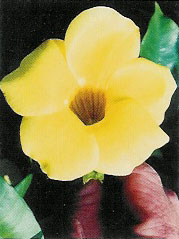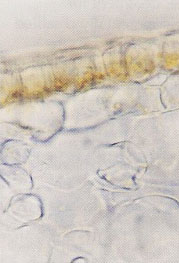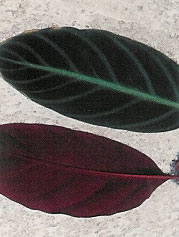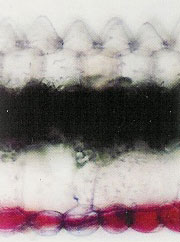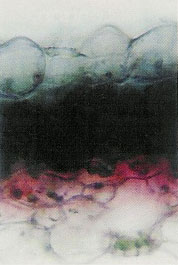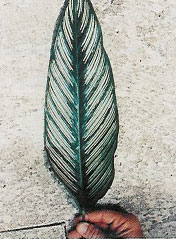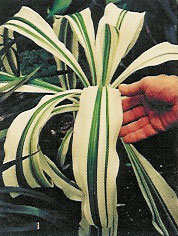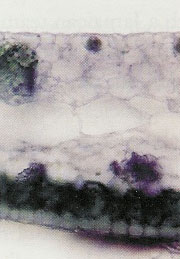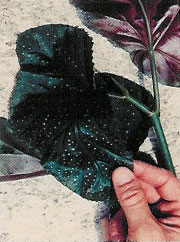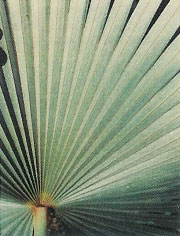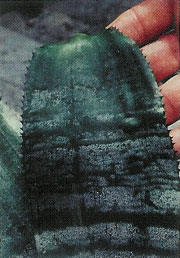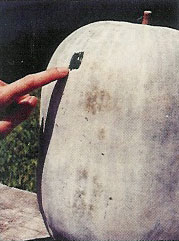Color in Plants
by Jack B. Fisher, Ph.D
Much of our love of plants comes from the beauty of their colors and the patterns their colors make. But exactly how do plants produce these colors? Botanist Jack Fisher helps answer this question.
To understand colors in pplants, we must make use of the microscope and look at mechanisms too small to be seen by the unaided eye. Some colors are due to chemical pigments within living cells; others result from microscopic structure and the way tissues are arranged.
The Green Leaf
Most plants are green due to chlorophyll pigment found within the many chloroplasts inside each green cell of the leaf. Every chloroplast is a microscopic factory that uses sunlight to produce sugar and chemical energy for the plant and oxygen gas for animals like us. The green color of sunlight is not used in this reaction and is reflected.
Flower and Fruit colors
Most red (Fig. A) and blue (Fig. B) flowers have a form of the pigment, anthocyanin, dissolved in the vacuoles of the epidermal cells of the petals. Subtle differences in hue are caused by chemical differences and the acidity (pH) of the vacuole sap. The surface structure of the petal, depending on the shape of the epidermal cells, gives the petal a glossy, mat, or velvety appearance. The color of many yellow (Fig. C) ahd orange flowers is derived from carotenoid pigments contained within the many tiny plastids of the epidermal cells and deep within the petal. The brightness of a color is ehhanced by an absence of chlorophyll and microscopic airspaces between cells under the pigmented epidermis. Fruits change color as they mature. For example, when a mango ripens, green chlorophyll is converted to orange carotenoid pigments; in chilli pepper, the carotenoid is yellow.
Color Patterns in Leaves
Shades of green are often caused by the amount of intercellular air spaces within the tissue. Air spaces reflect white light and the silvery appearance can mask the green light reflected by chlorophyll deeper in the leaf. Red anthocyanin pigment in cells on the lower surface give a red underside that is frequently seen (Fig. D). When viewed from above, the leaf is dark green or may even have a purple-black color (Fig. E). Symmetrical patterns of white and green are due to the absence of chlorophyll in some tissues (Fig. F, G). The chlorophyll-free regions can be white (due to intercellular air spaces) or light green (if another layer has some chlorophyll). White spots develop when colorless surface cells separate from green cells below (Fig. H).
Metallic Iridescence
Some leaves (Selaginella and some ferns) have an iridescent or metallic blue cast, especially when grown in deep shade. This effect is produced by a series of thin layers that act as interference or refraction filters, similar to the structural basis for metallic colors seen in insects and bird feathers. In plants, the layering is either part of the cell wall or the alignment of unusual chloroplasts. This mechanism was discovered in Miami by Prof. David Lee and colleagues at our partner university, Florida International University.
Silvery Color
The bright silvery surface of many leaves is due to light reflecting from microscopic air spaces. Green leaves look white or silvery because of a thick covering of surface hairs that are filled with air (Fig. I, J). If the hairs are wetted, as with a drop of rubbing alcohol, the airspaces within and between the hairs are filled and the green color of the underlying tissues is revealed. Other leaves (wax palm) and some fruits (plums and grapes) have a white “bloom” which is a surface deposit of wax. Particles of wax trap air and reflect light. When scratched with a finger nail, the wax is removed and we see the color beneath (Fig. K).
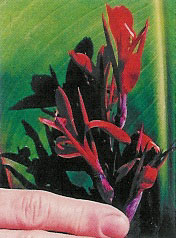
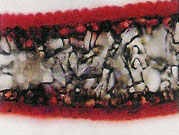
 x40
x40
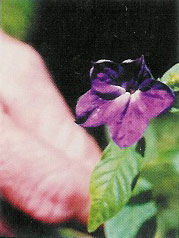
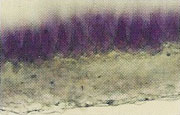
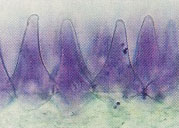 x40
x40
